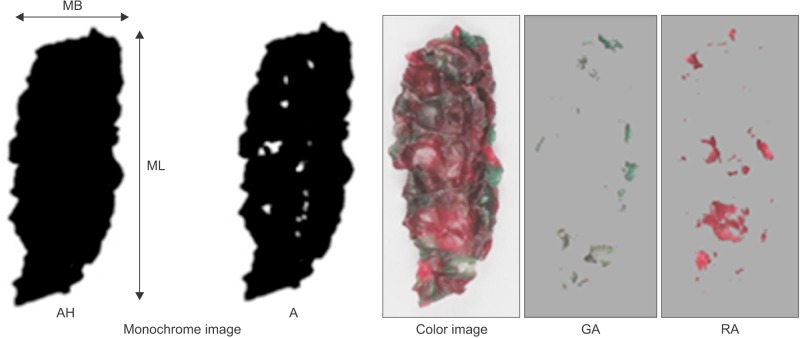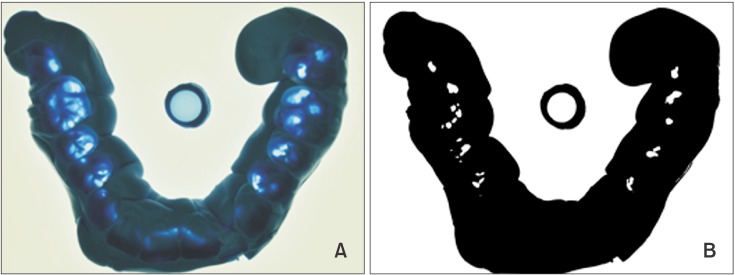Korean J Orthod.
2017 May;47(3):151-157. 10.4041/kjod.2017.47.3.151.
Comparison of masticatory efficiency according to Angle's classification of malocclusion
- Affiliations
-
- 1Department of Orthodontics, Pusan National University Dental Hospital, Yangsan, Korea. kimyongil@pusan.ac.kr
- 2Dental Research Institute, Pusan National University Dental Hospital, Yangsan, Korea.
- 3Institute of Translational Dental Sciences, Pusan National University, Busan, Korea.
- KMID: 2379648
- DOI: http://doi.org/10.4041/kjod.2017.47.3.151
Abstract
OBJECTIVE
The objective of this study was to investigate the differences in masticatory efficiency among patients with different Angle's classes of malocclusion and to assess the correlation between masticatory efficiency and the occlusal contact area.
METHODS
The mixing ability index (MAI) was calculated for measuring masticatory efficiency of 61 adult patients according to Angle's classifications of malocclusion. The study included 25, 15, and 21 patients with Angle's Class I, II, and III malocclusions, respectively. Silicone interocclusal recording material was used to measure the occlusal contact area.
RESULTS
Both the MAI and occlusal contact area showed the highest average values in the Class I malocclusion group, followed by the Class II and Class III malocclusion groups. No significant difference was observed in the MAI values between the Class I and Class II malocclusion groups (p > 0.05), whereas a significant difference was observed between the Class I and Class III malocclusion groups (p < 0.01) and between the Class II and Class III malocclusion groups (p < 0.05). A weak positive correlation was also observed between the MAI and occlusal contact area (p < 0.01, r² = 0.13).
CONCLUSIONS
The results of this study indicated that masticatory efficiency was the highest in patients with Angle's Class I malocclusion, followed by those with Angle's Class II and Angle's Class III malocclusions. Moreover, a weak positive correlation was observed between masticatory efficiency and the occlusal contact area.
Keyword
Figure
Reference
-
1. Buschang PH. Masticatory ability and performance: the effects of mutilated and maloccluded dentitions. Semin Orthod. 2006; 12:92–101.
Article2. Miura H, Miura K, Mizugai H, Arai Y, Umenai T, Isogai E. Chewing ability and quality of life among the elderly residing in a rural community in Japan. J Oral Rehabil. 2000; 27:731–734. PMID: 10931271.
Article3. Christiansen EG. The chewing power of teeth. Br Dent J. 1924; 45:318–319.4. Mahmood WA, Watson CJ, Ogden AR, Hawkins RV. Use of image analysis in determining masticatory efficiency in patients presenting for immediate dentures. Int J Prosthodont. 1992; 5:359–366. PMID: 1520458.5. Sato H, Fueki K, Sueda S, Sato S, Shiozaki T, Kato M, et al. A new and simple method for evaluating masticatory function using newly developed artificial test food. J Oral Rehabil. 2003; 30:68–73. PMID: 12485386.
Article6. Schimmel M, Christou P, Herrmann F, Müller F. A two-colour chewing gum test for masticatory efficiency: development of different assessment methods. J Oral Rehabil. 2007; 34:671–678. PMID: 17716266.
Article7. Horie T, Kanazawa M, Komagamine Y, Hama Y, Minakuchi S. Association between near occlusal contact areas and mixing ability. J Oral Rehabil. 2014; 41:829–835. PMID: 25155067.
Article8. Henrikson T, Ekberg EC, Nilner M. Masticatory efficiency and ability in relation to occlusion and mandibular dysfunction in girls. Int J Prosthodont. 1998; 11:125–132. PMID: 9709601.9. Tate GS, Throckmorton GS, Ellis E 3rd, Sinn DP. Masticatory performance, muscle activity, and occlusal force in preorthognathic surgery patients. J Oral Maxillofac Surg. 1994; 52:476–481. discussion 482. PMID: 8169710.
Article10. Wilding RJ. The association between chewing efficiency and occlusal contact area in man. Arch Oral Biol. 1993; 38:589–596. PMID: 8368956.
Article11. Hatch JP, Shinkai RS, Sakai S, Rugh JD, Paunovich ED. Determinants of masticatory performance in dentate adults. Arch Oral Biol. 2001; 46:641–648. PMID: 11369319.
Article12. Okiyama S, Ikebe K, Nokubi T. Association between masticatory performance and maximal occlusal force in young men. J Oral Rehabil. 2003; 30:278–282. PMID: 12588500.
Article13. Toro A, Buschang PH, Throckmorton G, Roldán S. Masticatory performance in children and adolescents with Class I and II malocclusions. Eur J Orthod. 2006; 28:112–119. PMID: 16272209.
Article14. English JD, Buschang PH, Throckmorton GS. Does malocclusion affect masticatory performance? Angle Orthod. 2002; 72:21–27. PMID: 11843269.15. Iwase M, Ohashi M, Tachibana H, Toyoshima T, Nagumo M. Bite force, occlusal contact area and masticatory efficiency before and after orthognathic surgical correction of mandibular prognathism. Int J Oral Maxillofac Surg. 2006; 35:1102–1107. PMID: 17097270.
Article16. Choi YJ, Lim H, Chung CJ, Park KH, Kim KH. Two-year follow-up of changes in bite force and occlusal contact area after intraoral vertical ramus osteotomy with and without Le Fort I osteotomy. Int J Oral Maxillofac Surg. 2014; 43:742–747. PMID: 24630069.
Article17. Katz MI. Angle classification revisited. 1: Is current use reliable? Am J Orthod Dentofacial Orthop. 1992; 102:173–179. PMID: 1342781.
Article18. Lee H, Kim M, Chun YS. Comparison of occlusal contact areas of class I and class II molar relationships at finishing using three-dimensional digital models. Korean J Orthod. 2015; 45:113–120. PMID: 26023539.
Article19. Kim KH, Choy KC, Kim HG, Park KH. Cephalometric norms of the hard tissues of Korean for orthognathic surgery. J Korean Assoc Oral Maxillofac Surg. 2001; 27:221–230.20. Carlsson GE. Masticatory efficiency: the effect of age, the loss of teeth and prosthetic rehabilitation. Int Dent J. 1984; 34:93–97. PMID: 6376372.21. Ackerman JL, Proffit WR. The characteristics of malocclusion: a modern approach to classification and diagnosis. Am J Orthod. 1969; 56:443–454. PMID: 5261158.22. Koshino H, Hirai T, Ishijima T, Ikeda Y. Tongue motor skills and masticatory performance in adult dentates, elderly dentates, and complete denture wearers. J Prosthet Dent. 1997; 77:147–152. PMID: 9051602.
Article23. van den Braber W, van der Glas HW, van der Bilt A, Bosman F. Chewing efficiency of pre-orthognathic surgery patients: selection and breakage of food particles. Eur J Oral Sci. 2001; 109:306–311. PMID: 11695750.
Article24. Zhou Y, Fu M. [Masticatory efficiency in skeletal class III malocclusion]. Zhonghua Kou Qiang Yi Xue Za Zhi. 1995; 30:72–74. 127Chinese. PMID: 7648921.25. Julien KC, Buschang PH, Throckmorton GS, Dechow PC. Normal masticatory performance in young adults and children. Arch Oral Biol. 1996; 41:69–75. PMID: 8833593.
Article26. Owens S, Buschang PH, Throckmorton GS, Palmer L, English J. Masticatory performance and areas of occlusal contact and near contact in subjects with normal occlusion and malocclusion. Am J Orthod Dentofacial Orthop. 2002; 121:602–609. PMID: 12080313.
Article27. Yoon HR, Choi YJ, Kim KH, Chung CR. Comparisons of occlusal force according to occlusal relationship, skeletal pattern, age and gender in Koreans. Korean J Orthod. 2010; 40:304–313.
Article28. Ando K, Kurosawa M, Fuwa Y, Kondo T, Goto S. A study on measuring occlusal contact area using silicone impression materials: an application of this method to the bite force measurement system using the pressure-sensitive sheet. Dent Mater J. 2007; 26:898–905. PMID: 18203497.
Article29. Magalhães IB, Pereira LJ, Marques LS, Gameiro GH. The influence of malocclusion on masticatory performance. A systematic review. Angle Orthod. 2010; 80:981–987. PMID: 20578873.
- Full Text Links
- Actions
-
Cited
- CITED
-
- Close
- Share
- Similar articles
-
- A study on positional change of the hyoid bone before and after activator therapy in angle's Class III malocclusion patients
- A comparative study of mandibular tooth development between Angle Class I malocclusion group and Angle Class III malocclusion group
- A study on calcification of the second molars in Angle Class I malocclusion
- A study on the prevalence of malocclusion in 2,378 Yonsei university students
- A study on the prevalence of the idiopathic osteosclerosis in Korean malocclusion patients





